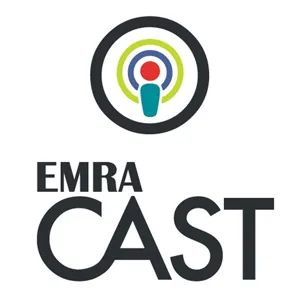Episode 13 - RUSM and Student Engagement

Explore "medstudents" with insightful episodes like "Episode 13 - RUSM and Student Engagement", "Flashback Friday: Lumps and Bumps: Can’t-Miss Diagnoses in Syncope", "No free medical advice", "Aging, cognitive function, and technology with Dr. Phillip D. Harvey" and "CV cost of smoking lasts a quarter century" from podcasts like ""Checking the Pulse: A Premed Podcast", "EMRA*Cast", "Postcall Podcast", "Psychcast" and "MDedge Cardiocast"" and more!


Dr. Jeremy Berberian joins EMRA*Cast with Alex Kaminsky to delve deeper into the pathophysiology and electrical findings associated with diagnoses such as WPW, Brugada and ARVD.
Lumps and Bumps: Can't-Miss Diagnoses in Syncope
Host: Alex Kaminsky
Guest: Jeremy Berberian, MD
EPISODE OVERVIEW
Residents are well-programmed to recognize cardiovascular emergencies such as STEMIs at a glance. However, during a busy shift it can be easy to overlook dysrhythmias and other electrophysiologic urgencies and emergencies. Syncope is a prime example of a chief complaint that may be uncovered with an EKG alone -- however, syncopal emergencies are often subtle and nuanced. Dr. Berberian joins EMRA*Cast with Alex Kaminsky to delve deeper into the pathophysiology and electrical findings associated with diagnoses such as WPW, Brugada, ARVD and more.
KEY POINTS
Wolff-Parkinson-White (WPW)
Prevalence: 0.7 to 1.7 per 10000
Overview
Accessory Pathway Connecting the atria to the ventricle. In some instances, this can cause the accessory pathway to travel FASTER than through the AV node.

Courtesy of CardioNetworks: Free use image
Key Features:
 Image: Courtesy of EMRA EKG Guide
Image: Courtesy of EMRA EKG Guide
Most common presentation is SVT. But also can present as atrial fibrillation.
Treatment
Orthodromic (Narrow): Treat like SVT
Key Point: Procainamide is the most safe chemical cardioversion in WPW as it does not directly affect the AV node. Use of AV-nodal blockers in WPW (including Amiodarone) increases the risk of VT/VF.
***Blocking the AV node in a WPW patient in Atrial Fibrillation can precipitate bad ventricular rhythms. If you see A-fib GREATER than 220 minus age -- consider WPW.***
Antidromic (Wide): Treat Like V-Tach
Brugada Syndrome
Prevalence: 5 in 10,000. Traditionally taught more common in Southeast Asian populations.
Overview
Sodium Channelopathy, which can lead to unstable dysrhythmias and ultimately cardiac death
Key Features
Diagnosis is made both by EKG and clinical criteria


Images: Courtesy of EMRA EKG Guide
Type 1:
Type 2:
Clinical Criteria (EKG Findings PLUS one or more):
Arrhythmogenic Right Ventricular Dysplasia/Cardiomyopathy (ARVD)
Prevalence: Unknown, likely more than we thought. Mean age is 31. Also we don't have great clinical criteria to full encompass this -- yet. Multiple genes linked to disease process. Variable inheritance patterns.
Overview
Fibro-Fatty infiltration of the myocardium that replaces good "conductive" tissue with fibrinous infiltrates. Think: "Kinda like cirrhosis of the heart."
Causes paroxysmal ventricular rhythms. Can present as CHF.
Key Features

Image: Courtesy of EMRA EKG Guide
Key Resources: *If needed and/or different than references*

Nick Andrews and Emi Okamoto, MD, talk about how to decrease the number of phone calls to your office, how more and more people view mental illness as a threat, and how to handle it when your family and friends ask for medical advice.
The interview this week is Taylor Brana, DO, the founder, producer, and host of the Happy Doc Podcast.
Timestamps:
Links:
For more MDedge Podcasts, go to mdedge.com/podcasts
Email the show: podcasts@mdedge.com

In this masterclass, Philip D. Harvey, PhD, professor of psychiatry and behavioral sciences at the University of Miami, discusses the relationships between aging, neurocognition, and functional outcomes.
And in a new segment from MDedge, called This Week in Psychiatry, we’d like to share a Current Psychiatry evidence-based review on using antidepressants for pediatric patients (PDF) by Jennifer B. Dwyer, MD, PhD, and Michael H. Bloch, MD, MS.
Show Notes by Jacqueline Posada, MD, consultation-liaison psychiatry fellow with the Inova Fairfax Hospital/George Washington University program in Falls Church, Va.
Introduction to normal aging
Technology and aging
Embracing technology to prevent normative cognitive decline
In summary, not all age-related cognitive complaints are pathological
References
Antidepressants for pediatric patients
by Jennifer B. Dwyer, MD, PhD; Michael H Bloch, MD, MD
An evidence-based review from Current Psychiatry: 2019 September:18(9):26-30,32-36,41-42,42A-42F
Tennstedt SL and FW Unverzagt. The ACTIVE study: Study overview and major findings. J Aging Health. 2013 Dec;25(8 0):3S-20S. doi: 10.1177/0898264313118133.
Rebok GW et al. Ten-year effects of the ACTIVE cognitive training trial on cognition and everyday functioning of older adults. J Am Geriatr Soc. 2014 Jan;62(1):16-24.
Harvey PD and MT Strassnig. Cognition and disability in schizophrenia: Cognition-related skills deficits and decision-making challenges add to morbidity. World Psychiatry. 2019 Jun;18(2):165-7.
Brem AK and SL Sensi. Towards combinational approaches for preserving cognitive function in aging. Trends Neurosci. 2018 Dec;41(2):885-97.

This week in cardiology:
You can contact the MDedge Cardiocast by emailing us at podcasts@mdedge.com or following us on Twitter at @MDedgeTweets.
Stay up to date
For any inquiries, please email us at hello@podcastworld.io